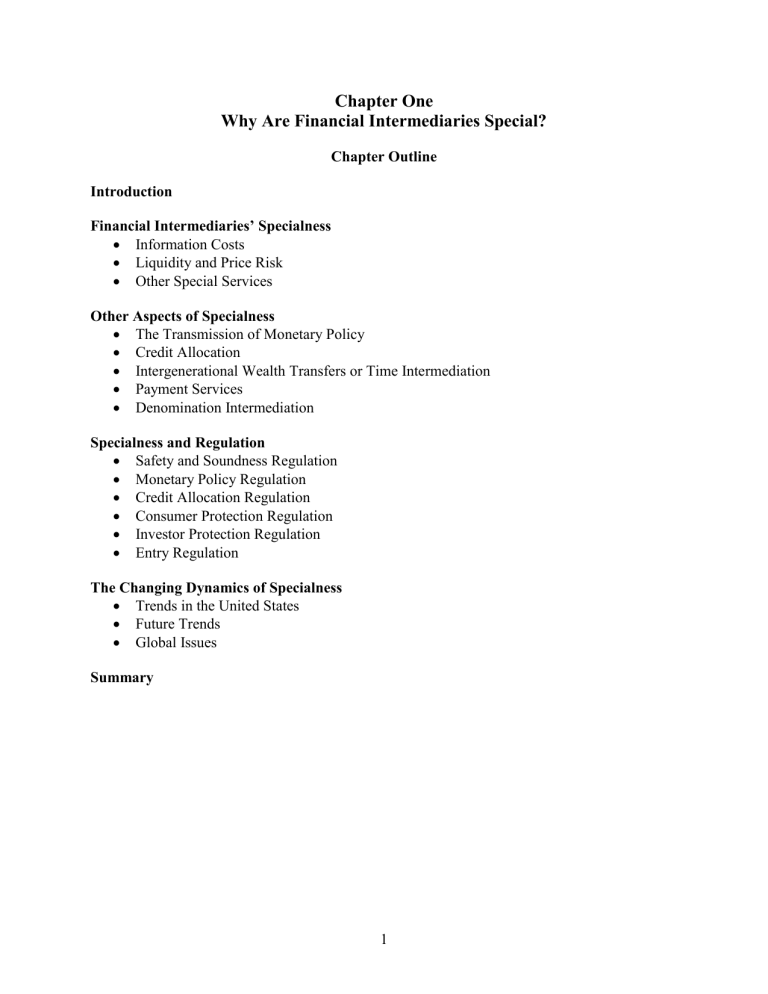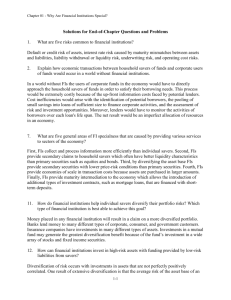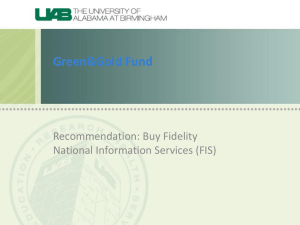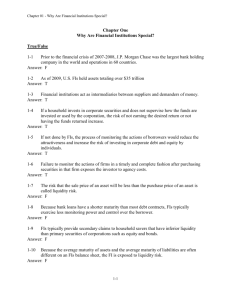Financial Intermediaries` Specialness

Chapter One
Why Are Financial Intermediaries Special?
Introduction
Financial Intermediaries’ Specialness
Information Costs
Liquidity and Price Risk
Other Special Services
Chapter Outline
Other Aspects of Specialness
The Transmission of Monetary Policy
Credit Allocation
Intergenerational Wealth Transfers or Time Intermediation
Payment Services
Denomination Intermediation
Specialness and Regulation
Safety and Soundness Regulation
Monetary Policy Regulation
Credit Allocation Regulation
Consumer Protection Regulation
Investor Protection Regulation
Entry Regulation
The Changing Dynamics of Specialness
Trends in the United States
Future Trends
Global Issues
Summary
1
Solutions for End-of-Chapter Questions and Problems: Chapter One
1. Identify and briefly explain the five risks common to financial institutions.
Default or credit risk of assets, interest rate risk caused by maturity mismatches between assets and liabilities, liability withdrawal or liquidity risk, underwriting risk, and operating cost risks.
2. Explain how economic transactions between household savers of funds and corporate users of funds would occur in a world without financial intermediaries (FIs).
In a world without FIs the users of corporate funds in the economy would have to approach directly the household savers of funds in order to satisfy their borrowing needs. This process would be extremely costly because of the up-front information costs faced by potential lenders.
Cost inefficiencies would arise with the identification of potential borrowers, the pooling of small savings into loans of sufficient size to finance corporate activities, and the assessment of risk and investment opportunities. Moreover, lenders would have to monitor the activities of borrowers over each loan's life span. The net result would be an imperfect allocation of resources in an economy.
3. Identify and explain three economic disincentives that probably would dampen the flow of funds between household savers of funds and corporate users of funds in an economic world without financial intermediaries.
Investors generally are averse to purchasing securities directly because of (a) monitoring costs,
(b) liquidity costs, and (c) price risk. Monitoring the activities of borrowers requires extensive time, expense, and expertise. As a result, households would prefer to leave this activity to others, and by definition, the resulting lack of monitoring would increase the riskiness of investing in corporate debt and equity markets. The long-term nature of corporate equity and debt would likely eliminate at least a portion of those households willing to lend money, as the preference of many for near-cash liquidity would dominate the extra returns which may be available. Third, the price risk of transactions on the secondary markets would increase without the information flows and services generated by high volume.
4. Identify and explain the two functions in which FIs may specialize that enable the smooth flow of funds from household savers to corporate users.
FIs serve as conduits between users and savers of funds by providing a brokerage function and by engaging in the asset transformation function. The brokerage function can benefit both savers and users of funds and can vary according to the firm. FIs may provide only transaction services, such as discount brokerages, or they also may offer advisory services which help reduce information costs, such as full-line firms like Merrill Lynch. The asset transformation function is accomplished by issuing their own securities, such as deposits and insurance policies that are more attractive to household savers, and using the proceeds to purchase the primary securities of corporations. Thus, FIs take on the costs associated with the purchase of securities.
2
5. In what sense are the financial claims of FIs considered secondary securities , while the financial claims of commercial corporations are considered primary securities ? How does the transformation process, or intermediation, reduce the risk, or economic disincentives, to the savers?
The funds raised by the financial claims issued by commercial corporations are used to invest in real assets. These financial claims, which are considered primary securities, are purchased by
FIs whose financial claims therefore are considered secondary securities. Savers who invest in the financial claims of FIs are indirectly investing in the primary securities of commercial corporations. However, the information gathering and evaluation expenses, monitoring expenses, liquidity costs, and price risk of placing the investments directly with the commercial corporation are reduced because of the efficiencies of the FI.
6. Explain how financial institutions act as delegated monitors. What secondary benefits often accrue to the entire financial system because of this monitoring process?
By putting excess funds into financial institutions, individual investors give to the FIs the responsibility of deciding who should receive the money and of ensuring that the money is utilized properly by the borrower. In this sense the depositors have delegated the FI to act as a monitor on their behalf. The FI can collect information more efficiently than individual investors. Further, the FI can utilize this information to create new products, such as commercial loans, that continually update the information pool. This more frequent monitoring process sends important informational signals to other participants in the market, a process that reduces information imperfection and asymmetry between the ultimate sources and users of funds in the economy.
7. What are five general areas of FI specialness that are caused by providing various services to sectors of the economy?
First, FIs collect and process information more efficiently than individual savers. Second, FIs provide secondary claims to household savers which often have better liquidity characteristics than primary securities such as equities and bonds. Third, by diversifying the asset base FIs provide secondary securities with lower price-risk conditions than primary securities. Fourth,
FIs provide economies of scale in transaction costs because assets are purchased in larger amounts. Finally, FIs provide maturity intermediation to the economy which allows the introduction of additional types of investment contracts, such as mortgage loans, that are financed with short-term deposits.
8. How do FIs solve the information and related agency costs when household savers invest directly in securities issued by corporations? What are agency costs?
Agency costs occur when owners or managers take actions that are not in the best interests of the equity investor or lender. These costs typically result from the failure to adequately monitor the activities of the borrower. If no other lender performs these tasks, the lender is subject to agency costs as the firm may not satisfy the covenants in the lending agreement. Because the FI invests the funds of many small savers, the FI has a greater incentive to collect information and monitor the activities of the borrower.
3
9. What often is the benefit to the lenders, borrowers, and financial markets in general of the solution to the information problem provided by the large financial institutions?
One benefit to the solution process is the development of new secondary securities that allow even further improvements in the monitoring process. An example is the bank loan that is renewed more quickly than long-term debt. The renewal process updates the financial and operating information of the firm more frequently, thereby reducing the need for restrictive bond covenants that may be difficult and costly to implement.
10. How do FIs alleviate the problem of liquidity risk faced by investors who wish to invest in the securities of corporations?
Liquidity risk occurs when savers are not able to sell their securities on demand. Commercial banks, for example, offer deposits that can be withdrawn at any time. Yet the banks make longterm loans or invest in illiquid assets because they are able to diversify their portfolios and better monitor the performance of firms that have borrowed or issued securities. Thus individual investors are able to realize the benefits of investing in primary assets without accepting the liquidity risk of direct investment.
11. How do financial institutions help individual savers diversify their portfolio risks? Which type of financial institution is best able to achieve this goal?
Money placed in any financial institution will result in a claim on a more diversified portfolio.
Banks lend money to many different types of corporate, consumer, and government customers, and insurance companies have investments in many different types of assets. Investment in a mutual fund may generate the greatest diversification benefit because of the fund’s investment in a wide array of stocks and fixed income securities.
12. How can financial institutions invest in high-risk assets with funding provided by low-risk liabilities from savers?
Diversification of risk occurs with investments in assets that are not perfectly positively correlated. One result of extensive diversification is that the average risk of the asset base of an
FI will be less than the average risk of the individual assets in which it has invested. Thus individual investors realize some of the returns of high-risk assets without accepting the corresponding risk characteristics.
13. How can individual savers use financial institutions to reduce the transaction costs of investing in financial assets?
By pooling the assets of many small investors, FIs can gain economies of scale in transaction costs. This benefit occurs whether the FI is lending to a corporate or retail customer, or purchasing assets in the money and capital markets. In either case, operating activities that are designed to deal in large volumes typically are more efficient than those activities designed for small volumes.
4
14. What is maturity intermediation ? What are some of the ways in which the risks of maturity intermediation are managed by financial intermediaries?
If net borrowers and net lenders have different optimal time horizons, FIs can service both sectors by matching their asset and liability maturities through on- and off-balance sheet hedging activities and flexible access to the financial markets. For example, the FI can offer the relatively short-term liabilities desired by households and also satisfy the demand for long-term loans such as home mortgages. By investing in a portfolio of long-and short-term assets that have variable- and fixed-rate components, the FI can reduce maturity risk exposure by utilizing liabilities that have similar variable- and fixed-rate characteristics, or by using futures, options, swaps, and other derivative products.
15. What are five areas of institution-specific FI specialness, and which types of institutions are most likely to be the service providers?
First, commercial banks and other depository institutions are key players for the transmission of monetary policy from the central bank to the rest of the economy. Second, specific FIs often are identified as the major source of finance for certain sectors of the economy. For example, S&Ls and savings banks traditionally serve the credit needs of the residential real estate market. Third, life insurance and pension funds commonly are encouraged to provide mechanisms to transfer wealth across generations. Fourth, depository institutions efficiently provide payment services to benefit the economy. Finally, mutual funds provide denomination intermediation by allowing small investors to purchase pieces of assets with large minimum sizes such as negotiable CDs and commercial paper issues.
16. How do depository institutions such as commercial banks assist in the implementation and transmission of monetary policy?
The Federal Reserve Board can involve directly the commercial banks in the implementation of monetary policy through changes in the reserve requirements and the discount rate. The open market sale and purchase of Treasury securities by the Fed involves the banks in the implementation of monetary policy in a less direct manner.
17. What is meant by credit allocation regulation? What social benefit is this type of regulation intended to provide?
Credit allocation regulation refers to the requirement faced by FIs to lend to certain sectors of the economy, which are considered to be socially important. These may include housing and farming. Presumably the provision of credit to make houses more affordable or farms more viable leads to a more stable and productive society.
18. Which intermediaries best fulfill the intergenerational wealth transfer function? What is this wealth transfer process?
Life insurance and pension funds often receive special taxation relief and other subsidies to assist in the transfer of wealth from one generation to another. In effect, the wealth transfer process
5
allows the accumulation of wealth by one generation to be transferred directly to one or more younger generations by establishing life insurance policies and trust provisions in pension plans.
Often this wealth transfer process avoids the full marginal tax treatment that a direct payment would incur.
19. What are two of the most important payment services provided by financial institutions?
To what extent do these services efficiently provide benefits to the economy?
The two most important payment services are check clearing and wire transfer services. Any breakdown in these systems would produce gridlock in the payment system with resulting harmful effects to the economy at both the domestic and potentially the international level.
20. What is denomination intermediation? How do FIs assist in this process?
Denomination intermediation is the process whereby small investors are able to purchase pieces of assets that normally are sold only in large denominations. Individual savers often invest small amounts in mutual funds. The mutual funds pool these small amounts and purchase negotiable
CDs which can only be sold in minimum increments of $100,000, but which often are sold in million dollar packages. Similarly, commercial paper often is sold only in minimum amounts of
$250,000. Therefore small investors can benefit in the returns and low risk which these assets typically offer.
21. What is negative externality ? In what ways do the existence of negative externalities justify the extra regulatory attention received by financial institutions?
A negative externality refers to the action by one party that has an adverse affect on some third party who is not part of the original transaction. For example, in an industrial setting, smoke from a factory that lowers surrounding property values may be viewed as a negative externality.
For financial institutions, one concern is the contagion effect that can arise when the failure of one FI can cast doubt on the solvency of other institutions in that industry.
22. If financial markets operated perfectly and costlessly, would there be a need for financial intermediaries?
To a certain extent, financial intermediation exists because of financial market imperfections. If information is available costlessly to all participants, savers would not need intermediaries to act as either their brokers or their delegated monitors. However, if there are social benefits to intermediation, such as the transmission of monetary policy or credit allocation, then FIs would exist even in the absence of financial market imperfections.
23. What is mortgage redlining?
Mortgage redlining occurs when a lender specifically defines a geographic area in which it refuses to make any loans. The term arose because of the area often was outlined on a map with a red pencil.
6
24. Why are FIs among the most regulated sectors in the world? When is net regulatory burden positive?
FIs are required to enhance the efficient operation of the economy. Successful financial intermediaries provide sources of financing that fund economic growth opportunity that ultimately raises the overall level of economic activity. Moreover, successful financial intermediaries provide transaction services to the economy that facilitate trade and wealth accumulation.
Conversely, distressed FIs create negative externalities for the entire economy. That is, the adverse impact of an FI failure is greater than just the loss to shareholders and other private claimants on the FI's assets. For example, the local market suffers if an FI fails and other FIs also may be thrown into financial distress by a contagion effect. Therefore, since some of the costs of the failure of an FI are generally borne by society at large, the government intervenes in the management of these institutions to protect society's interests. This intervention takes the form of regulation.
However, the need for regulation to minimize social costs may impose private costs to the firms that would not exist without regulation. This additional private cost is defined as a net regulatory burden. Examples include the cost of holding excess capital and/or excess reserves and the extra costs of providing information. Although they may be socially beneficial, these costs add to private operating costs. To the extent that these additional costs help to avoid negative externalities and to ensure the smooth and efficient operation of the economy, the net regulatory burden is positive.
25. What forms of protection and regulation do regulators of FIs impose to ensure their safety and soundness?
Regulators have issued several guidelines to insure the safety and soundness of FIs: a. FIs are required to diversify their assets. For example, banks cannot lend more than 10 percent of their equity to a single borrower. b. FIs are required to maintain minimum amounts of capital to cushion any unexpected losses.
In the case of banks, the Basle standards require a minimum core and supplementary capital of 8 percent of their risk-adjusted assets. c. Regulators have set up guaranty funds such as BIF for commercial banks, SIPC for securities firms, and state guaranty funds for insurance firms to protect individual investors. d. Regulators also engage in periodic monitoring and surveillance, such as on-site examinations, and request periodic information from the FIs.
26. In the transmission of monetary policy, what is the difference between inside money and outside money ? How does the Federal Reserve Board try to control the amount of inside money? How can this regulatory position create a cost for the depository financial institutions?
7
Outside money is that part of the money supply directly produced and controlled by the Fed, for example, coins and currency. Inside money refers to bank deposits not directly controlled by the
Fed. The Fed can influence this amount of money by reserve requirement and discount rate policies. In cases where the level of required reserves exceeds the level considered optimal by the FI, the inability to use the excess reserves to generate revenue may be considered a tax or cost of providing intermediation.
27. What are some examples of credit allocation regulation? How can this attempt to create social benefits create costs to the private institution?
The qualified thrift lender test (QTL) requires thrifts to hold 65 percent of their assets in residential mortgage-related assets to retain the thrift charter. Some states have enacted usury laws that place maximum restrictions on the interest rates that can be charged on mortgages and/or consumer loans. These types of restrictions often create additional operating costs to the
FI and almost certainly reduce the amount of profit that could be realized without such regulation.
28. What is the purpose of the Home Mortgage Disclosure Act? What are the social benefits desired from the legislation? How does the implementation of this legislation create a net regulatory burden on financial institutions?
The HMDA was passed by Congress to prevent discrimination in mortgage lending. The social benefit is to ensure that everyone who qualifies financially is provided the opportunity to purchase a house should they so desire. The regulatory burden has been to require a written statement indicating the reasons why credit was or was not granted. Since 1990, the federal regulators have examined millions of mortgage transactions from more than 7,700 institutions each calendar quarter.
29. What legislation has been passed specifically to protect investors who use investment banks directly or indirectly to purchase securities? Give some examples of the types of abuses for which protection is provided.
The Securities Acts of 1933 and 1934 and the Investment Company Act of 1940 were passed by
Congress to protect investors against possible abuses such as insider trading, lack of disclosure, outright malfeasance, and breach of fiduciary responsibilities.
30. How do regulations regarding barriers to entry and the scope of permitted activities affect the charter value of financial institutions?
The profitability of existing firms will be increased as the direct and indirect costs of establishing competition increase. Direct costs include the actual physical and financial costs of establishing a business. In the case of FIs, the financial costs include raising the necessary minimum capital to receive a charter. Indirect costs include permission from regulatory authorities to receive a charter. Again in the case of FIs this cost involves acceptable leadership to the regulators. As these barriers to entry are stronger, the charter value for existing firms will be higher.
8
31. What reasons have been given for the growth of investment companies at the expense of
“traditional” banks and insurance companies?
The recent growth of investment companies can be attributed to two major factors: a. Investors have demanded increased access to direct securities markets. Investment companies and pension funds allow investors to take positions in direct securities markets while still obtaining the risk diversification, monitoring, and transactional efficiency benefits of financial intermediation. Some experts would argue that this growth is the result of increased sophistication on the part of investors; others would argue that the ability to use these markets has caused the increased investor awareness. The growth in these assets is inarguable. b. Recent episodes of financial distress in both the banking and insurance industries have led to an increase in regulation and governmental oversight, thereby increasing the net regulatory burden of “traditional” companies. As such, the costs of intermediation have increased, which increases the cost of providing services to customers.
32. What are some of the methods which banking organizations have employed to reduce the net regulatory burden? What has been the effect on profitability?
Through regulatory changes, FIs have begun changing the mix of business products offered to individual users and providers of funds. For example, banks have acquired mutual funds, have expanded their asset and pension fund management businesses, and have increased the security underwriting activities. In addition, legislation that allows banks to establish branches anywhere in the United States has caused a wave of mergers. As the size of banks has grown, an expansion of possible product offerings has created the potential for lower service costs. Finally, the emphasis in recent years has been on products that generate increases in fee income, and the entire banking industry has benefited from increased profitability in recent years.
33. What characteristics of financial products are necessary for financial markets to become efficient alternatives to financial intermediaries? Can you give some examples of the commoditization of products which were previously the sole property of financial institutions?
Financial markets can replace FIs in the delivery of products that (1) have standardized terms, (2) serve a large number of customers, and (3) are sufficiently understood for investors to be comfortable in assessing their prices. When these three characteristics are met, the products often can be treated as commodities. One example of this process is the migration of over-thecounter options to the publicly traded option markets as trading volume grows and trading terms become standardized.
34. In what way has Regulation 144A of the Securities and Exchange Commission provided an incentive to the process of financial disintermediation?
9
Changing technology and a reduction in information costs are rapidly changing the nature of financial transactions, enabling savers to access issuers of securities directly. Section 144A of the
SEC is a recent regulatory change that will facilitate the process of disintermediation. The private placement of bonds and equities directly by the issuing firm is an example of a product that historically has been the domain of investment bankers. Although historically private placement assets had restrictions against trading, regulators have given permission for these assets to trade among large investors who have assets of more than $100 million. As the market grows, this minimum asset size restriction may be reduced.
10











